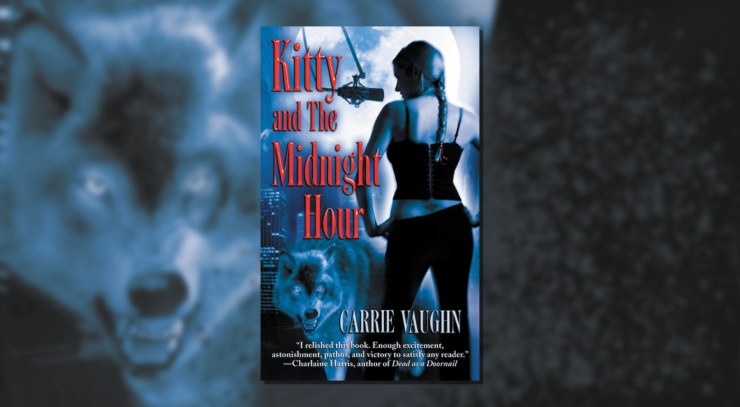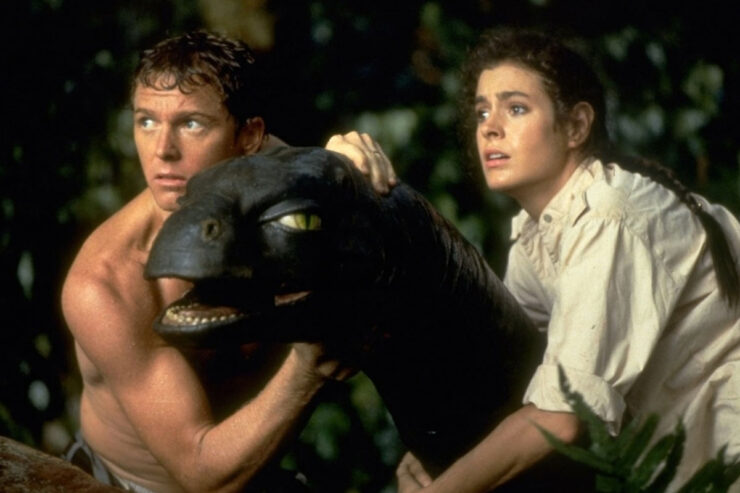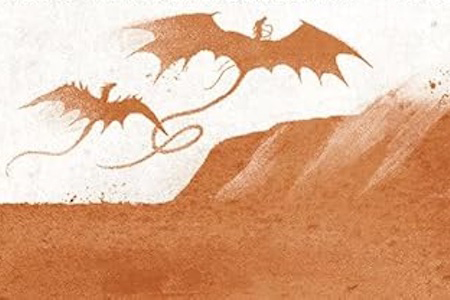In the tradition of Buffy the Vampire Slayer, the cheerleader-cute blonde with the cute all-American-of-a-certain-demographic name, we have here a series of bestselling novels staring Kitty the werewolf. Kitty Norville is blonde and cheerleader-cute, though closer to Kristy Swanson’s film-Buffy version than Sarah Michelle Gellar’s more petite television Buffy. She first appears in Kitty and the Midnight Hour, published in 2005—just a few years removed from the television series.
Kitty’s name is a gimmick, but the book is solid urban fantasy. It’s not twee or cute and the most part it’s not playing for laughs. Kitty was, like Buffy, a normal American girl, until one traumatic night, she had a very bad date that ended in a werewolf attack.
The date and the werewolf are two different people, but they’re the same kind of predator. Kitty can and does stay well away from the date, but she’s bound to the werewolf by the law and custom of the pack. In the first volume, she transforms from helpless, submissive werewolf cub to more mature, more confident young wolf—and woman.
The key to the transformation is the late-night radio show she hosts in Denver, The Midnight Hour. It begins as a standard radio DJ gig, playing mostly oldies on request to night owls and insomniacs. One night the show takes a turn, and she finds herself giving advice about, and to, supernatural beings. Werewolves and vampires mainly, but other varieties come and go as the series progresses.
The new version of the show is a huge hit. Within days it goes into syndication, and Kitty becomes a celebrity. Then, again by accident, she’s outed as a werewolf—and the show really takes off.
There’s a sexy werewolf (and vampire) hunter, a murderous rogue werewolf, an equally murderous vampire clan, a seen-it-all police detective, a secret government project, a Deep Throat-style whistleblower, a revolving cast of callers to the show, and central to it all, and to Kitty’s life, the pack of werewolves to which she belongs. It’s led by Carl, the alpha, and his alpha-bitch mate, Meg. Zan, the werewolf who infected Kitty with the disease, is a constant irritant and relentless bully. His foil is the relatively gentle TJ, Kitty’s best friend and mentor within the pack.
Kitty is the bottom of the heap within the pack, the youngest and weakest. After three years as a werewolf, she’s utterly submissive, particularly to Carl, and she hero-worships Meg. She hasn’t told her family what she is, though she constantly has to miss important events because they happen around the full moon. She’s barely making it financially, emotionally, or psychologically.
The show’s transformation brings out a similar transformation in Kitty. The more confident she becomes, the harder it is for the pack to accept. Then a hunter comes for her—and it doesn’t turn out at all as the person who sent him intended.
In 2005, plots constructed around physical and emotional abuse were more acceptable than they are now. There are serious examples of both in Kitty and the Midnight Hour. The main arc of Kitty’s personal narrative is her recognition of the abuse she suffers, and her resistance to it.
Kitty does not begin as a standard-issue urban-fantasy Strong Female Character. She’s weak, she’s codependent, she’s bullied. It takes an ongoing series of attacks, injuries, and shocking revelations to wake her up to what’s been done to her. She grows into agency.
The werewolves of this universe are, unlike Kitty-as-protagonist, pretty much standard. They transform fully into wolves, though it’s possible, with some effort, to stop partway. Transformation during the three days of the full moon is compulsory; they can’t not do it. But they can shift at any time, if they’re willing to risk losing their human mind and form.
In wolf form, they have fairly high intelligence, but the predator overwhelms the human. They may or may not remember what happens while running as wolves, though the sensation of being Wolf is with them constantly. Wolf, as Kitty puts it, is always under the skin.
In human form, a werewolf has enhanced strength and a keen sense of smell. If wounded, she heals with supernatural speed. She can be killed by being either torn apart or shot or stabbed with silver.
Werewolf pack culture is based on what we now know is an erroneous perception of wolf social structure. The concept of the Alpha Wolf has been debunked. Wolfpacks, it turns out, are nuclear family groups, parents and offspring. Parents are in charge, offspring occupy shifting positions in the pack depending on age and personality. As they grow up and find mates, they move away and form their own packs.
But hey. This is fantasy. If werewolves need to be based on the Alpha model in order for the plot to work, that’s how it is.
Kitty is an abuse survivor, both sexual and familial. Carl dominates her sexually as well as physically. In return she’s made to feel safe and protected, though in fact, as she comes to learn, she’s neither. And that’s part of the abuse cycle, too.
What makes the book work for me in spite of the very dark parts of its worldbuilding is the author’s voice speaking through Kitty—clear, focused, sure of its powers—and the characters who serve as counterweights to the bullies and abusers. TJ the werewolf mentor and friend, Cormac the hunter, Hardin the police detective, Matt the sound guy, and later Ben the lawyer, show Kitty how to be strong and how to stand up for herself. At the end of the first volume, Kitty still has a long way to go, but there literally is no going back. At least not in her immediate future.
It’s a solid start to an intriguing series. I’ll be reading more of it. It’s got that nice strong authorial voice, and characters I’d like to revisit. In the mystery genre, of which urban fantasy is frequently a subset, that’s a good sign.
I’m not enthralled with the werewolves, to be honest. But Alphas and packs are pretty much how it works in the genre (for example Kelley Armstrong’s Bitten, which is of similar vintage), and it looks as if we may be encountering other forms of shifter as the series goes on. I’m there for the Bat Boy, and there are hints of other possibilities—tiger, selkie. That could get interesting.
Judith Tarr is a lifelong horse person. She supports her habit by writing works of fantasy and science fiction as well as historical novels, many of which have been published as ebooks. She’s written a primer for writers who want to write about horses: Writing Horses: The Fine Art of Getting It Right. She lives near Tucson, Arizona with a herd of Lipizzans, a clowder of cats, and a blue-eyed dog.















I read a comment somewhere (I think TV Tropes?) that the alpha werewolf thing is sort of accidentally correct; the wolves in the original study acted super-hierarchical because they were a bunch of unrelated strangers forced to form a pack together, which is often how werewolves work.
It’s what I whisper to myself as I read a werewolf story that I want to suspend my disbelief* for, anyway; you may or may not find it helpful.
*Human transforming into an animal once a month? We see no problem whatsoever, says brain. Magical humanimal has a basically human mind but with ~animal vibes~? Everything’s fine. ~Animal vibes~ are inaccurate for that animal? Uh oh, need to take several deep breaths and recite the MST3K Mantra until the Inner Zoology Nerd calms down.
Clearly the corrupting influence in werewolves is the human part, not the wolf part. If they were all wolf, they’d be much better at family dynamics.
Kitty sounds interesting if only because the urban fantasy heroines in the books I’ve read are usually fairly tough even before the monster stuff starts happening.
As I recall, some of the later Kitty books reveal that there are werewolves and vampires who find other ways to live than the hierarchical pack and the hierarchical family. Carl’s pack is awful in large part because Carl (and Meg) are bad people.
Good to see you discussing this series! I enjoyed it from the library enough to collect my own copies, and have read them at least twice. I really like the entire world she created, and it’s different enough from some of my other favorites (Patricia Briggs’ wolves are quite different) that it makes a nice contrast.
Carrie Vaughn has also written about a few spin-off characters (Cormac the sexy vampire hunter and Rick the conquistador vampire) and those stories are worth investigating, too. Vampire monks? New idea! One of the things I like best about the series is that Kitty does get her HEA. The short stories about Kitty have been collected in a couple of volumes, which is nice.
@1 Thank you, that does make sense. And as @3 says, the main deal is that Carl and Meg are not good people. The best thing that happens to Kitty is having to go out on her own.
@@.-@ I like that the vampires in this world are not default-evil. Vampire monks is so much fun to contemplate.